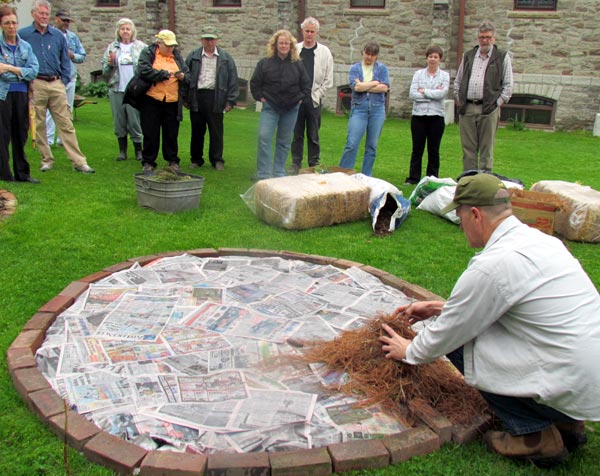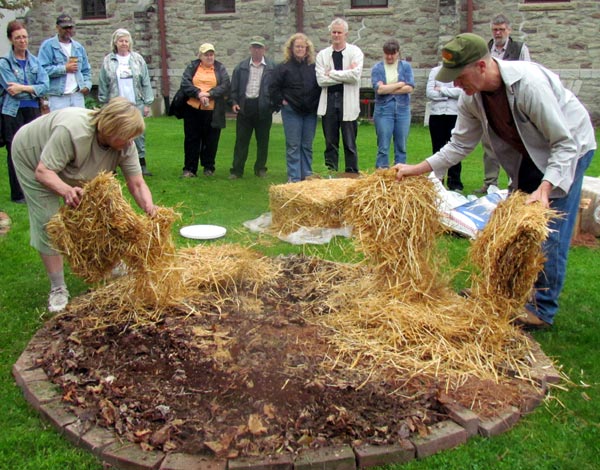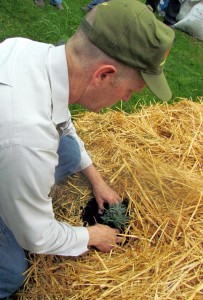10 steps to a ‘groan free’ vegetable garden
Administrator | May 18, 2011 | Comments 0
Prince Edward County’s David Riley took the groan out of gardening last weekend for a few dozen people who witnessed how easy it is to turn a patch of ground into a diverse vegetable garden – in about half an hour. Riley has been hosting workshops in the community gardens at St. Andrew’s Presbyterian Church, Picton for the past few years. He educates the public through a variety of workshops – including the easy-on-your-back Sheet Mulch technique, also known as ‘Lasagna’ gardening.
“Some people don’t like the look of this kind of garden because it’s not traditional,” he said. “But there’s no back work and it shows you don’t need to grow the traditional rows of food unless you’re on a tractor.” He discussed one of the gardens planted at last year’s demonstration noting its yield included tomatoes, peppers and eggplant among other things. “Lasagna gardening gives you a garden. It’s a good yield – not the biggest – but if is often just what many people need, especially those who have small yards. We use all the concepts of permaculture – friendly to people, wildlife and your environment because it’s a natural eco-system.”
Riley recommends people get more information on sheet mulch gardening at the library or bookstore. In the meantime, the following is a quick 10-step method he demonstrated. With the time you’ve saved, visit Terra Vista and the Picton Home Hardware for all your garden and landscaping supplies.
 STEP ONE: Soak a patch of grass with water. Spread out several layers of newspaper in the shape of your choice. Do not use glossy paper and don’t worry about the ink, as most newspapers use vegetable-based inks. David Riley creates a standard eight foot circle at the community gardens at St. Andrew’s Church, Picton. Water the paper.
STEP ONE: Soak a patch of grass with water. Spread out several layers of newspaper in the shape of your choice. Do not use glossy paper and don’t worry about the ink, as most newspapers use vegetable-based inks. David Riley creates a standard eight foot circle at the community gardens at St. Andrew’s Church, Picton. Water the paper.
 STEP TWO: Build a border around your garden using bricks, rocks, stones or wood. Put down pine needles or wood chips to create a footpath to the centre of the garden. This keyhole allows you to reach every plant from the inside of the circle.
STEP TWO: Build a border around your garden using bricks, rocks, stones or wood. Put down pine needles or wood chips to create a footpath to the centre of the garden. This keyhole allows you to reach every plant from the inside of the circle.
 STEP THREE: Start building a rich, earthy, microbe-filled environment with a layer of compost.
STEP THREE: Start building a rich, earthy, microbe-filled environment with a layer of compost.
 STEP FOUR: Add a variety of natural soil amendments such as manure, bone meal, leaves, grass clippings, coffee grounds. “It’s all about diversity in the garden,” Riley says. “Everybody lives together and think about all the metaphors that go with that.”
STEP FOUR: Add a variety of natural soil amendments such as manure, bone meal, leaves, grass clippings, coffee grounds. “It’s all about diversity in the garden,” Riley says. “Everybody lives together and think about all the metaphors that go with that.”
 STEP FIVE: Add more compost. Avoid synthetic products, Riley advises. Synthetic nitrogen can reduce soil carbon, making the soil less fertile. Artificial fertilizers can increase the plants’ uptake of water, bloating them, causing the root hairs to shut down and starving the soil life, which is normally given sugars by the plants in a symbiotic exchange. Bloated plants are more likely to attract pest insects and suffer fungal attacks. He also noted plants don’t like tobacco – so if you’re a smoker, wash your hands before you garden.
STEP FIVE: Add more compost. Avoid synthetic products, Riley advises. Synthetic nitrogen can reduce soil carbon, making the soil less fertile. Artificial fertilizers can increase the plants’ uptake of water, bloating them, causing the root hairs to shut down and starving the soil life, which is normally given sugars by the plants in a symbiotic exchange. Bloated plants are more likely to attract pest insects and suffer fungal attacks. He also noted plants don’t like tobacco – so if you’re a smoker, wash your hands before you garden.
 STEP SIX: Spread out a healthy amount of straw or hay. “A first the height of the straw may seem a bit ridiculous,” Riley says. “Don’t worry about it. It levels itself out.” In year two gardens, the choice of keeping or replacing the straw is “entirely up to you.”
STEP SIX: Spread out a healthy amount of straw or hay. “A first the height of the straw may seem a bit ridiculous,” Riley says. “Don’t worry about it. It levels itself out.” In year two gardens, the choice of keeping or replacing the straw is “entirely up to you.”
 STEP SEVEN: Make wells in the straw right down to the newspaper. When planting in the sheet mulch, dig down with your hand to the paper layer and cut an ‘X’ through the paper with a knife.
STEP SEVEN: Make wells in the straw right down to the newspaper. When planting in the sheet mulch, dig down with your hand to the paper layer and cut an ‘X’ through the paper with a knife.
 STEP EIGHT: Fill the hole in the straw with soil.
STEP EIGHT: Fill the hole in the straw with soil.
 STEP NINE: Plant your seedling in the soil. Keep the mulch off the stem of the plant. Plant more things every few days, or weeks, just like in a normal garden. For those who wish to grow potatoes, lift the straw on the outside of the garden and place the potatoes on the grass. No digging necessary. The yield, he says, is not as much as in the digging method butit provides a plentiful crop for the homeowner.
STEP NINE: Plant your seedling in the soil. Keep the mulch off the stem of the plant. Plant more things every few days, or weeks, just like in a normal garden. For those who wish to grow potatoes, lift the straw on the outside of the garden and place the potatoes on the grass. No digging necessary. The yield, he says, is not as much as in the digging method butit provides a plentiful crop for the homeowner.
 STEP TEN: Watch everything grow! There’s no need for bending and weeding every day. Riley notes that rather than fighting against nature, it is easier to work with a natural system by observing how it behaves in the absence of humans. Mimicking the natural system in the garden and on your entire property is the goal.
STEP TEN: Watch everything grow! There’s no need for bending and weeding every day. Riley notes that rather than fighting against nature, it is easier to work with a natural system by observing how it behaves in the absence of humans. Mimicking the natural system in the garden and on your entire property is the goal.
Filed Under: Local News
About the Author:
































